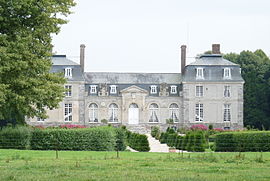This article includes a list of general references, but it lacks sufficient corresponding inline citations. (September 2018) |
Saint-Sylvain (French pronunciation: [sɛ̃ silvɛ̃] ⓘ) is a commune in the Seine-Maritime department in the Normandy region in northern France.
Saint-Sylvain | |
|---|---|
 The chateau of Anglesqueville-les-Murs | |
| Coordinates: 49°50′47″N 0°40′25″E / 49.8464°N 0.6736°E | |
| Country | France |
| Region | Normandy |
| Department | Seine-Maritime |
| Arrondissement | Dieppe |
| Canton | Saint-Valery-en-Caux |
| Intercommunality | CC Côte d'Albâtre |
| Government | |
| • Mayor (2020–2026) | Sandrine Losay-Annebique[1] |
| Area 1 | 3.24 km2 (1.25 sq mi) |
| Population (2021)[2] | 138 |
| • Density | 43/km2 (110/sq mi) |
| Time zone | UTC+01:00 (CET) |
| • Summer (DST) | UTC+02:00 (CEST) |
| INSEE/Postal code | 76651 /76460 |
| Elevation | 0–83 m (0–272 ft) (avg. 70 m or 230 ft) |
| 1 French Land Register data, which excludes lakes, ponds, glaciers > 1 km2 (0.386 sq mi or 247 acres) and river estuaries. | |
Geography edit
A small farming village situated in the Pays de Caux, some 24 miles (39 km) west of Dieppe at the junction of the D68 and the D105 roads. Huge chalk cliffs rise up from the pebbly beach and overlook the English Channel, forming the northern border of the commune's territory.
Heraldry edit
| The arms of Saint-Martin-Sylvain are blazoned : Azure, a chevron Or semy of trefoils between 2 lances and a man's head argent, and on a chief argent a lion between 2 hammers gules.
|
Population edit
| Year | Pop. | ±% p.a. |
|---|---|---|
| 1968 | 191 | — |
| 1975 | 157 | −2.76% |
| 1982 | 178 | +1.81% |
| 1990 | 223 | +2.86% |
| 1999 | 212 | −0.56% |
| 2007 | 178 | −2.16% |
| 2012 | 183 | +0.56% |
| 2017 | 179 | −0.44% |
| Source: INSEE[3] | ||
Places of interest edit
- The church of St.Silvain, dating from the thirteenth century.
- A sixteenth-century stone cross.
- The thirteenth-century château of Anglesqueville-les-Mur.
See also edit
References edit
- ^ Liste des maires du département de la Seine-Maritime, 10 August 2020
- ^ "Populations légales 2021". The National Institute of Statistics and Economic Studies. 28 December 2023.
- ^ Population en historique depuis 1968, INSEE
Wikimedia Commons has media related to Saint-Sylvain (Seine-Maritime).



